Queen of Heaven
The oldest evidence of faith in a Heavenly Mother dates back some 7000-7500 years (radiocarbon dating). The writings on an amulet found in Tatárlaka, located in historical Hungary (Tataria, Romania, since the Trianon Dictate of 1920) attests to Man, struggling with adversity, petitioning the Heavenly Mother for help. The prayer reads:
"Protector of Tur-Dis (Tordos): Grand Lady, cognizant of all secrets, may Your Caring Two Eyes guard us in the light of our Father-Sun."
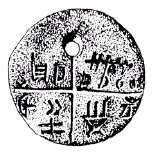
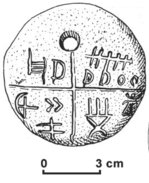
26 goddess figurines are also found next to the amulet, as testaments to the worship of the same Mother Goddess. The people who live here regard eternal divine care as the Heavenly Mother's kindness extended to everyone. This is their belief, the same belief the Scythians of Scythopolis, the “goiims,” “people of other faiths,” of Galilee profess. Material testing confirms that the clay is of local composition. As expected, the discovery of the Tatárlaka religious artifacts, which predate even Sumerian finds, have opened new debates concerning the beliefs of the people who lived there and their relationship to the peoples history calls Sumerians.
We find evidence of worship of the Mother Goddess elsewhere, too. Uruk, Mesopotamia, is Inanna's holy city where her worship is practiced at the highest level, so let us dig around there. In our search of the religious practices of an age, we look for surviving symbols and interpret them using our knowledge of that age. And so it is in the case of a bird-headed goddess with child figurines found in the antediluvian layers at the site of excavations of Ur, Mesopotamia. Here, we find the symbols of “sun-worshipers,” people who symbolize an inconceivable God by the sun. One is Im-Dugud, Tur-ullu, “New Light” or “Child of Light” (L.144, 441), Turul, the mythical falcon, symbol of Hungarian spiritual identity. It is found everywhere; on ancient Sumerian artifacts, 1st century Parthian royal crowns, Atilla's banners, Árpád's standards, and on the Hungarian military coat of arms, emblems, badges and decorations to this day. The other symbol is the lion, "House of the Sun" in the Sumerian zodiac. We can confirm the relationship between the lion and the Virgin Mother by identifying the Rosetta worn by the Scythian Virgin Mother with that on the lion's flank in the sanctuary of Ister-Gam castle (Esztergom, pre-14th century capital of Hungary on the shores of the Danube [formerly Ister] river). During the Marxist terror rule of Béla Kun (born Jewish, Khon), the Basilica of Esztergom is "vandalized," and of the seven pairs of Lions of Ister-Gam, thirteen are scraped off by "unknown perpetrators;" that is, perpetrators who know the meaning of these symbols, but are tasked to destroy evidence of the Queen of Heaven-Virgin Mother-Innana-Ilama-Mary faith.
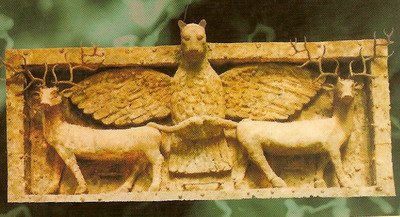
2500 BC composite titled Tur-Ullu depicting the combined symbols, Turul and Lion, “Child of Light in the House of the Sun.” The stags represent Nib-Ur's (Nimrod) sons (peoples), Hunor and Magor (Hungarian mythology)
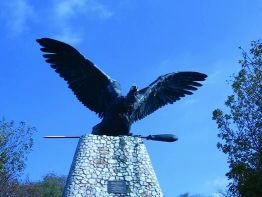
15m. (49 ft.) wing-span copper statue of the Turul in Tatabánya, Hungary
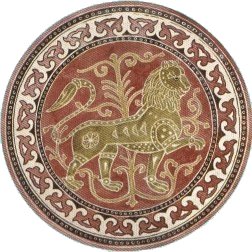
Lions of Eszergom. (Esztergom is located some 15km. from Dobogókő, site of the phenomenon variably translated as Beating Heart Stone [ancient Hungarian faith], and Earth Heart Chakra [the 14th Dalai Lama]).
The Queen of Heaven is the main character of Sumerian spirituality. She is the Holy Innana, Gingir Ilama (Tündér Ilona; Tündér, Hungarian for Fairy). She is also called the number 40 in memory of her mystical resurrection after forty days. Hence, her name is also written as Nin. Her symbol is four cuneiform wedges, the number forty, which is still visible on the body of the lion of Esztergom.
Our most accessible source that speaks of the Heavenly Queen is the Bible. Here, in the Book of Jeremiah, we hear courageous Semites rejecting Jeremiah's Judaism and new god, Yahweh:
"As for the message that you have spoken to us in the name of the Lord, we are not going to listen to you! But rather we will certainly carry out every word that has proceeded from our mouths, by burning sacrifices to the Queen of Heaven and pouring out drink offerings to her, just as we ourselves, our forefathers, our kings and our princes did in the cities of Judea and in the streets of Jerusalem; for then we had plenty of food and were well off and saw no misfortune. But since we stopped burning sacrifices to the Queen of Heaven and pouring out drink offerings to her, we have lacked everything and have met our end by the sword and by famine. 'And,' said the women, 'when we were burning sacrifices to the Queen of Heaven and were pouring out drink offerings to her, was it without our husbands that we made for her sacrificial cakes in her image and poured out drink offerings to her?'" (Jeremiah (44:16-19).
Who could be this deity the Semites of Jeremiah's time revere when they reject Judaism and the new Jewish god, Yahweh? Where does this reverence, found in the remnants of their folklore as "our forefathers," originate? According to professional literature (Masoretic Text, Targum), the Queen of Heaven is also portrayed as the Star of Heaven. But in that case, the reference is to Istar, Venus, Morning Star. In Mesopotamia, she is known as Innana or Ninana; in Egypt, Isis; in Carthage, Tanit; and to the Turanian people, her name is Ana-Hita. She is the Greek Demeter, Aphrodite; the Roman Minerva and Venus. To followers of the Jesus Faith, she is Mary, Jesus' mother, who has been since eternity, the incarnation of the Virgin of Light who took part in the great Creation; just as her son, Jesus is the incarnation of the Son of Light. Hence, the Mother from her Son, and the Son from his Mother are inseparable.
To Hungarians, since time immemorial, she is known as "Boldogasszony." "Our Mother Boldogasszony”: this is how Hungarians petition their Heavenly Mother. And, by Boldogasszony, everyone means Jesus' Mother, Mary. Ida Bobula, in her discussion, Ősvallás Istenasszonya, proves fairly well that the Hungarian people already had their Boldogasszony long before conversion to the Roman religion, and that, on the recommendation of bishop Gellért, Stephen I orders that Boldogasszony be Mary. And that is just fine, because Jesus' Mother is the Heavenly Boldogasszony incarnate, and because the Roman religion likewise considers her Queen of the Heaven and believes in Mary, a Virgin Mother, just as she is the goddess of the ancient Sumerian faith. (Note: Translation of the compound word Boldogasszony (boldog: blissful) and Istenasszony (Isten: God) is difficult because no English equivalent exists for asszony, a word for a woman of the highest social stature. Customarily, Boldogasszony is translated as Blessed Lady, Our Lady, Notre Dame, Madonna, and so forth.)
Even Christian Catholicism has not been able to completely erase her divinity from people's consciousness despite Church efforts to turn her name, “Morning Star,” into Christianity's demon, “Fallen Angel,” Lucifer, whom it identifies with Judaism's Satan. (Lucifer [Light-bringer] is the Latin name for "Morning Star," both in prose and poetry, since, at least, Varro Reatinus [116–27 BC], Cicero [106-43 BC] and other early Latin writers). The Litany of the Blessed Virgin Mary (Loreto) still contains the line, "Morning Star pray for us." And we read in 2 Peter 1:19: ”...until the day dawns and the Morning Star rises in your hearts.” And Mary is usually depicted standing above the crescent moon—though the praying faithful no longer knows why—symbolizing Archmagus Gabriel's Annunciation, “the Morning Star above the crest of the New Moon that shines beneath her feet.” And this seems to be an accurate portrayal of the Virgin Mary, since both Innana incarnate and the Parthian Queen of Heaven are associated with the crescent moon.
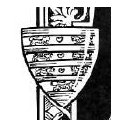
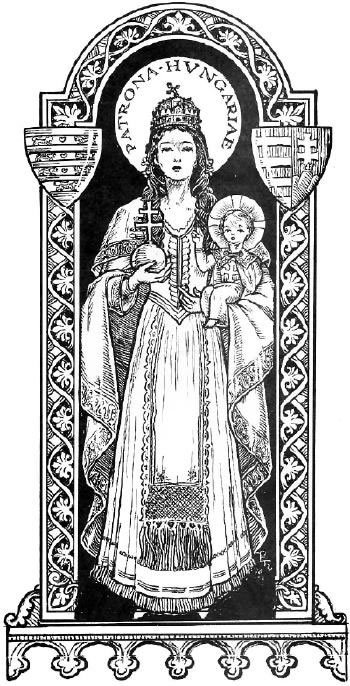
Patrona Hungaria associated with the lion symbol (7 lions on her shield)
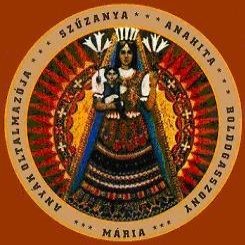
Scythian-Hungarian Anahita, Boldogasszony, Virgin Mother, Mary, Protector of Mothers. Folk art.
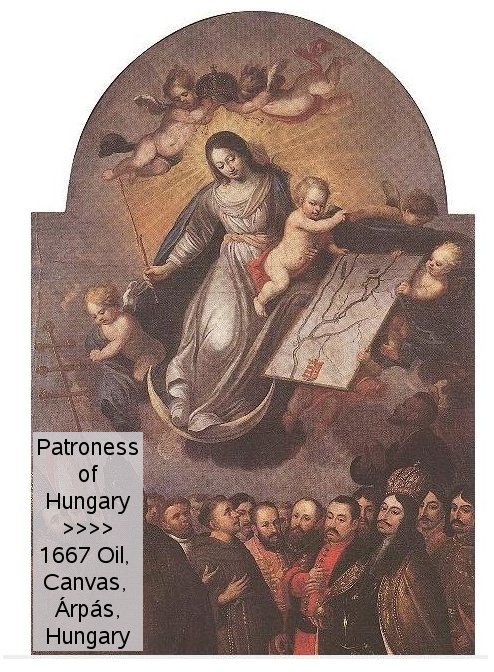
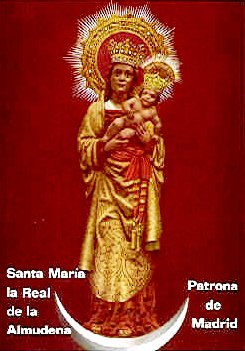
Mary, Morning Star, standing above the crescent moon.
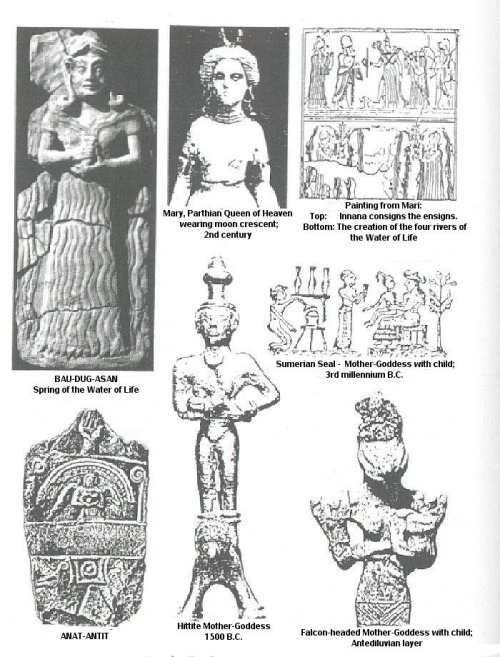
Early Sumarian “written” communication relied heavily on symbolism (logograms—also known as ideograms or hieroglyphics—and phonograms) to convey thoughts. Above, the antediluvian (6th millennium BC, or earlier) statue of the falcon-headed woman with child is read, “Mother of the Child of Light” (variably, “Mother of the New Light”). Popularized creative—often fantastic—interpretations of the ancient Sumerians' spirituality are either the products of imagination born out of ignorance of this culture-specific “written language” or deliberate disinformation.

